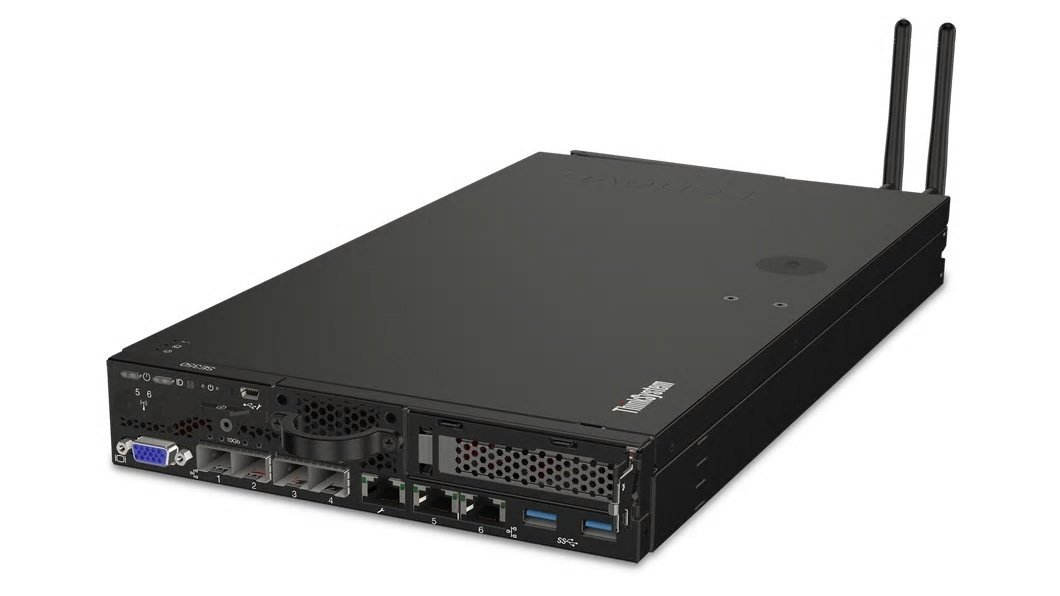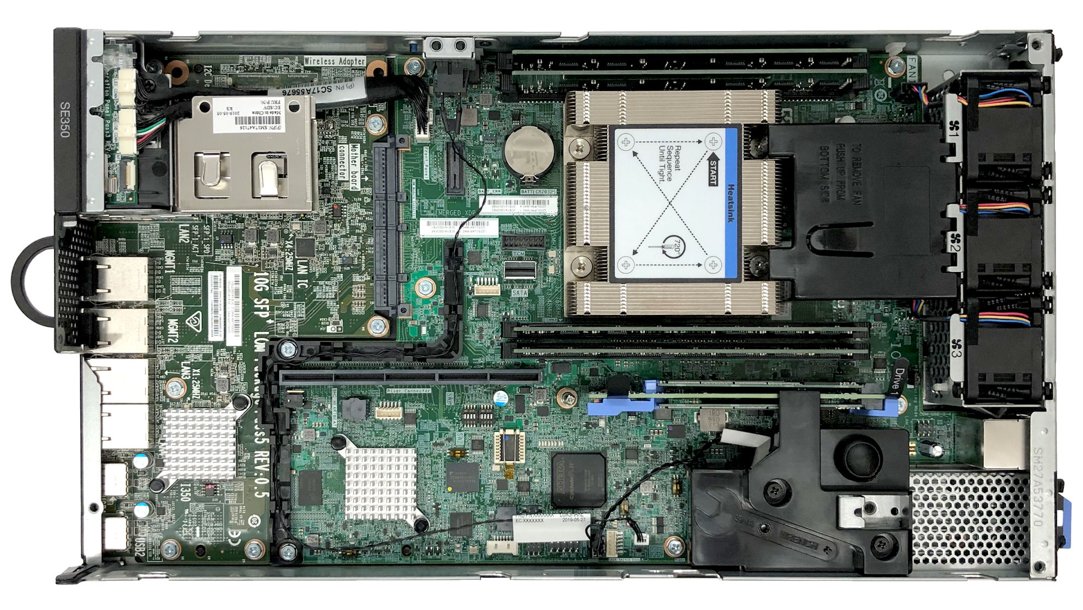Lenovo ThinkSystem SE350 Edge Server review: Lenovo gets close to the edge
Lenovo’s near notebook-sized SE350 goes where other servers fear to tread


-
+
Supports Xeon D-2100 edge computing CPUs
-
+
Clever M.2 storage options
-
+
Very expandable
-
+
Smart security features
-
+
Good remote management
-
-
High spec models can be pricey

Lenovo’s rapidly expanding ThinkSystem family is going in new directions, as signalled by the ThinkSystem SE350 with its sharp focus on edge computing. Targeting applications such as IoT, retail, surveillance, building control plus manufacturing and distribution environments, the SE350 is presented in an ultra-compact chassis that’s built to work in rugged environments.
The 1U high chassis measures a mere 21cm wide and 38cm deep, is shock and vibration resistant and can handle ambient temperatures up to 55 degrees C. Its modest dimensions mean you can rack it, stack it, wall mount it, hang it from the ceiling or squeeze it into tight spaces and if you want to show it off, Lenovo offers a range of bookshelf stand kits that can take up to three servers.
This compactness doesn’t come at the cost of features, either; the SE350 supports a Xeon D-2100 CPU with up to 16 cores, 256GB of Lenovo’s TruDDR4 memory and a maximum of two M.2 boot drives and eight M.2 SATA or NVMe data drives. Network choices are equally good as the SE350 is offered with a range of 10GbE modules plus wireless and LTE options and is even 5G-ready.
As the SE350 is likely to be deployed in the wild, Lenovo offers fast deployment services and has implemented some smart security measures. Along with M.2 SED (self-encrypting drive) support, the system incorporates an intrusion sensor plus a customisable motion detector and if either are triggered, you can set the server to go into lockdown mode.
Lenovo ThinkSystem SE350 Edge Server review: Design and features
The SE350 is solidly built and whipping the lid off reveals a very well-designed interior. The Xeon D-2100 CPU sits to the rear on the left, is covered with a large passive heatsink and flanked on each side by two DIMM slots. Base systems start with 8GB of TruDDR4 memory, which can be boosted to 128GB using RDIMMs or 256GB with LRDIMMs.

All cooling is managed by three cold-swap dual rotor fans behind the CPU socket which provide N+1 redundancy, so the server will continue to operate if one fails. Power is handled by chunky external power distribution modules (PDMs) and you can specify either one or two with the second providing redundancy.
In front of the CPU is a bracket for the slide-out system ID tab and snuggling up alongside is Lenovo’s optional dual 11ac WiFi and LTE module. The antennae are cabled through to screw mounts at the rear for external aerials, but you won’t be able to use these if the server is mounted in the 1U or 2U rack enclosures.
Sign up today and you will receive a free copy of our Future Focus 2025 report - the leading guidance on AI, cybersecurity and other IT challenges as per 700+ senior executives
The server is available with a choice of three network modules which fit in a dedicated edge slot on the main board and present their ports across the front panel. Connection options abound - the modules offer a range of copper or fibre Gigabit and 10GbE ports, along with one or two Gigabit ports for connection to the server’s embedded XCC (xClarity Controller) remote management chip.
Lenovo ThinkSystem SE350 Edge Server review: Storage and expansion
The SE350 offers a surprisingly good range of storage choices, which start with a boot adapter mounted in a dedicated slot at the rear. You can choose the single M.2 SATA enablement kit or fit the mirroring version which has two M.2 slots.
Further forward, you have a slot for a horizontal riser cage with two models available. One has 4-bay M.2 data drive adapters on both wings while another has a standard 16X PCI-E slot on the right wing. This arrangement adds a lot of storage versatility as you could have a maximum of two boot storage devices and eight data drives. Even better, both wings can support SATA or NVMe SSDs, although you can’t mix them in the same adapter.

The PCI-E slot has other possible uses, and supports a range of standard Gigabit and 10GbE network adapter cards. The SE350 can also handle graphics intensive workloads - our system was supplied with an Nvidia Tesla T4 GPU card.
Lenovo ThinkSystem SE350 Edge Server review: Deployment and management
The SE350 sports the same XCC controller as all other ThinkSystem servers, which can be accessed at boot up where it presents a provisioning manager. It provides easy access for configuring the server, updating firmware and creating RAID arrays while its automated OS deployment tool helped us install Windows Server 2019 in under 30 minutes.
The XCC’s web console presents plenty of information about critical hardware components and puts hardware inventory and firmware upgrade tools at your fingertips. The Utilization page only provides data on voltages and fan speeds, and to get the graphs on CPU, memory, I/O and system usage, you’ll need to purchase an XCC feature on demand (FoD) license.
One smart feature is the Edge Networking page where you can apply topology presets to all the network ports. These allow you to define which ones are controlled by the OS, those set for cloud uplinks, edge downlinks or clusters and whether the WiFi adapter will function as an AP or a client.
The XCC console also allows you to enable tamper and motion detection. For the latter, you choose what orientation the server is in and when triggered, decide whether it should be powered down and if BMC access should be disabled.
Lenovo ThinkSystem SE350 Edge Server review: Verdict
The high-end system Lenovo supplied to us for review shows clearly what the SE350 can do but it will set you back around $11,600. For those with more modest demands, entry-level systems start at a more affordable $1,825 and sport a 4-core 2.2GHz Xeon D-2123IT CPU with 8GB of TruDDR4.
A competitor to the SE350 is HPE’s EdgeLine range, although some of these are over four years old and support equally elderly Moonshot (anyone remember that?) server cartridges. The SE350 is clearly a significantly more powerful and versatile alternative, making it a great choice for businesses that want to easily push processing out to the network edge right where the data is being generated.
Lenovo ThinkSystem SE350 Edge Server specifications (As reviewed)
| Chassis | 1U half-width, short-depth rack |
| CPU | 16-core 2.2GHz Intel Xeon D-2183IT |
| Memory | 256GB 2,400MHz TruDDR4 (max 256GB) |
| Storage | 2 x 480GB M.2 SATA SSDs (boot), 2 x 960GB SATA SED (data) |
| RAID | ThinkSystem M.2 Enablement Kit (RAID0, 1) |
| Network | 2 x Gigabit SFP, 2 x Gigabit copper, 2 x 10GbE SFP+, 11ac WiFi, LTE |
| Expansion | Riser with 16X PCI-e 3.0 slot and 4-bay SATA/NMVe adapter |
| Graphics | Nvidia Tesla T4 16GB passive GPU card |
| Power | 2 x external PSUs |
| Management | XCC with Gigabit, XClarity Administrator |
| Warranty | 1Yr Premier Foundation On-Site NBD |
Dave is an IT consultant and freelance journalist specialising in hands-on reviews of computer networking products covering all market sectors from small businesses to enterprises. Founder of Binary Testing Ltd – the UK’s premier independent network testing laboratory - Dave has over 45 years of experience in the IT industry.
Dave has produced many thousands of in-depth business networking product reviews from his lab which have been reproduced globally. Writing for ITPro and its sister title, PC Pro, he covers all areas of business IT infrastructure, including servers, storage, network security, data protection, cloud, infrastructure and services.
-
 Trump's AI executive order could leave US in a 'regulatory vacuum'
Trump's AI executive order could leave US in a 'regulatory vacuum'News Citing a "patchwork of 50 different regulatory regimes" and "ideological bias", President Trump wants rules to be set at a federal level
By Emma Woollacott Published
-
 Microsoft Excel is still alive and kicking at 40 – and it's surging in popularity as 82% of finance professionals report ‘emotional attachment’ to the spreadsheet software
Microsoft Excel is still alive and kicking at 40 – and it's surging in popularity as 82% of finance professionals report ‘emotional attachment’ to the spreadsheet softwareNews A recent survey found Gen Z and Millennial finance professionals have a strong “emotional attachment” to Microsoft Excel
By Emma Woollacott Published
-
 LastPass hit with ICO fine after 2022 data breach exposed 1.6 million users – here’s how the incident unfolded
LastPass hit with ICO fine after 2022 data breach exposed 1.6 million users – here’s how the incident unfoldedNews The impact of the LastPass breach was felt by customers as late as December 2024
By Emma Woollacott Published
